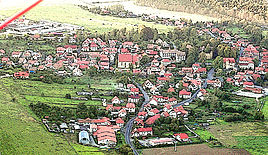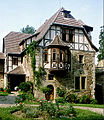Bibra (grave field)
|
Bibra
Municipality grave field
|
|
|---|---|
| Coordinates: 50 ° 28 ′ 11 ″ N , 10 ° 26 ′ 24 ″ E | |
| Height : | 362 m above sea level NN |
| Area : | 9.7 km² |
| Residents : | 582 (Jun. 30, 2015) |
| Population density : | 60 inhabitants / km² |
| Incorporation : | December 1, 2007 |
| Postal code : | 98631 |
| Area code : | 036944 |
|
Location of Bibra in Grabfeld
|
|
|
Aerial view of the place, looking north
|
|
Bibra is a village in the district of Schmalkalden-Meiningen in the Franconian region of southern Thuringia . Since December 1, 2007, the formerly politically independent municipality has been part of the Grabfeld municipality .
geography
Bibra is located about twelve kilometers south of Meiningen in the valley of the Bibra stream of the same name and forms the gateway to the historic Grabfeld landscape between Thuringia and Bavaria (Grabfeldpforte).
history
Bibra was first mentioned in a document in 825 in a deed of donation to the Fulda monastery . In 1119 the nobleman was called "Rubertus de Bybera". These gentlemen were free of the empire and were therefore very much courted by the authorities. Finally, in 1343, the bishopric succeeded in securing suzerainty. 1486 was by Emperor Friedrich III. granted the market right. The castle Bibra stormed 1,525 farmers and destroyed. Reconstruction takes place in 1526. After another destruction in 1646, it was rebuilt and rebuilt. On November 30, 1693, the town's greatest son, the composer Christoph Förster , was born in Bibra, where he also received his first lessons from the organist Johann Phillip Pitzler (died 1722) before moving to Weißenfels to Johann David Heinichen , who Was a composition teacher. The lords of Bibra were accepted into the imperial knighthood in 1805 . In 1808 the dukes of Saxony-Meiningen acquired the place and incorporated it into the Maßfeld office . Today the well-preserved complex is owned by the Bibra noble society.
politics
The district council of Bibra is made up of seven councilors. The last mayor before the incorporation in 2007 was Antje Vogler. The current mayor of the district is Heidrun Kellermann.
Culture and sights
Historical monuments
- Since 1992 Oskar-Meyer-Platz has been commemorating the last member of the Jewish community who was deported to the Theresienstadt concentration camp in 1943. The synagogue at Hauptstrasse 10 , built in 1846, was desecrated during the November pogrom in 1938 and later served as a warehouse for the Johannes Herbig company . Until 1938 there was also a hachshara camp in the village , which prepared Jewish youths for emigration to Palestine . The local Jews emigrated or were subjected to extermination by the Nazi regime . In 2007 a memorial was erected on Oskar-Meyer-Platz in memory of the Jews who were expelled, deported and murdered between 1933 and 1945
St. Leo Church
Albrecht von Bibra
window of St. Leo (Bibra) c.1492Kilian from Bibra
Window of St. Leo (Bibra) c.1492Lorenz von Bibra
Window of St. Leo (Bibra) c.1492Riemenschneider commemorative medal (1950) from Helmut König (medalist)
Buildings
- The foundation stone for the single-nave late Gothic St. Leo Church , which is still worth seeing today, was laid in 1492, and it was completed in 1503. In this church there are significant Tilman Riemenschneider altars: the Apostle Altar, Church Fathers Altar and Annunciation Altar.
- The Lower Bibra Castle was built in 1558.
- Bibra Castle
- Motorway church on the “Thüringer Tor” rest area on federal motorway 71. It was opened in 2015 and has been called “Church of Unity - Autumn '89” since 2019.
traffic
Bibra has a stop on the Schweinfurt – Meiningen railway line . The junction Rentwertshausen of the federal highway 71 is two kilometers south.
Sons and daughters of the church
- 1953, March 14th Klaus Seifert (refugee) , † May 4th 1971, fatality on the inner-German border
See also
literature
- Wilhelm Freiherr von Bibra: History of the family of the Freiherrn von Bibra. Kaiser, Munich 1870, ( digitized version ).
- Wilhelm Freiherr von Bibra: Contributions to the family history of the imperial barons of Bibra. 3 volumes. Kaiser, Munich 1880–1888, ( online ).
- Heinrich Hartmann: The market town Bibra. A representation of his political and ecclesiastical development. Festschrift for the 400th anniversary of the laying of the foundation stone of the church, July 17, 1892 (= publications of the Association for Meiningische Geschichte und Landeskunde. Issue 13, ZDB -ID 513328-2 ). L. v. Eyes bookstore, Meiningen 1892, ( digitized ).
- Herbert von Hintzenstern : The altars in Bibra. From Riemenschneider's workshop. 2nd Edition. Evangelical Publishing House, Berlin 1969.
- Herbert von Hintzenstern: From Würzburg to Bibra, Riemenschneider altars in Thuringia. Evangelische Verlagsanstalt, Berlin 1987, ISBN 3-374-00214-5 .
- Martin Stingl: Imperial freedom and prince service. The service relations of the von Bibra. 1500 to 1806 (= publications of the Society for Franconian History. Row 9: depictions from Franconian history. 41). Degener & Co, Neustadt ad Aisch 1994, ISBN 3-7686-9131-4 (also: Erlangen, University, dissertation, 1993).
- Werner Wagenhöfer: The Bibra. Studies and materials on the genealogy and ownership history of a Franconian lower nobility family in the late Middle Ages (= publications of the Society for Franconian History. Series 9: Representations from Franconian history. 45). Degener & Co, Neustadt ad Aisch 1998, ISBN 3-7686-9147-0 (Also: Würzburg, University, dissertation, 1996/1997).
- The investigation and restoration of the Annunciation altar and a Corpus Christi from the Evangelical Church of St. Leo in Bibra (= workbooks of the Thuringian State Office for Monument Preservation. NF 3). Reinhold, Altenburg 2001, ISBN 3-910166-53-9 .
Web links
- thueringenfotos.de - Photos from the village from 1976
- thueringenfotos.de - Photos from the village from 1989
- thueringenfotos.de - Photos from the village from 1990
- Official website of Burg Bibra eV
- Bibra on the VG Grabfeld website
- Page at Thuringia Info ( Memento from September 27, 2007 in the Internet Archive )
Individual evidence
- ^ StBA: Changes in the municipalities in Germany, see 2007
- ↑ exchange of territory in 1808 Rhon lexicon
- ↑ Thomas Bienert: Medieval castles in Thuringia. 430 castles, castle ruins and fortifications. Wartberg Verlag, Gudensberg-Gleichen 2000, ISBN 3-86134-631-1 , p. 247.
- ↑ Hanns Friedrich: Autobahn Church A71 now has a name . In: Main-Post, Rhön-Grabfeld issue, 23 September 2019.















